
|
It brightened up to 6.2 mag in June (June 24, Marco Goiato). Now it is fading. It has already faded down to 10.6 mag (Aug. 8, Chris Wyatt). It is observable in excellent condition in the Southern Hemisphere. In the Northern Hemisphere, it locates low in the south.
Date(TT) R.A. (2000) Decl. Delta r Elong. m1 Best Time(A, h)
Aug. 13 14 19.78 -30 13.0 1.969 2.095 82 9.7 18:52 ( 92, 64)
Aug. 20 14 18.20 -29 19.1 2.188 2.167 75 10.1 18:57 ( 89, 57)
|
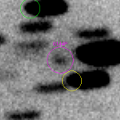
|
It became so bright as 8 mag in 2009. Appearing in the morning sky. In the Northern Hemispehre, it will be observable at 11-12 mag from summer to autumn. In the Southern Hemisphere, it keeps extremely low for a long time until autumn. Now it is 15.2 mag (Aug. 1, Jean-Francois Soulier), fainter than this ephemeris.
Date(TT) R.A. (2000) Decl. Delta r Elong. m1 Best Time(A, h)
Aug. 13 7 24.04 20 58.5 2.218 1.446 30 11.6 5:17 (242, 3)
Aug. 20 7 48.26 19 49.2 2.193 1.437 31 11.4 5:09 (243, 3)
|
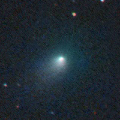
|
Now it is 10.3 mag (July 31, Marco Goiato). It keeps 11-12 mag until September. In the Northern Hemisphere, it keeps low for a long time after this.. In the Southern Hemisphere, it keeps observable in good condition for a long time.
Date(TT) R.A. (2000) Decl. Delta r Elong. m1 Best Time(A, h)
Aug. 13 14 10.14 -14 18.0 1.464 1.546 74 11.6 18:52 (117, 54)
Aug. 20 14 28.52 -16 39.6 1.510 1.552 72 11.7 18:57 (110, 53)
|
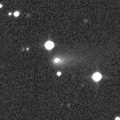
|
Now it is 12.3 mag (Aug. 4, Michael Jager). It is observable at 12 mag from summer to autumn. Now it is appearing in the morning sky, but it keeps low for some time.
Date(TT) R.A. (2000) Decl. Delta r Elong. m1 Best Time(A, h)
Aug. 13 6 55.70 21 38.5 2.015 1.360 37 12.1 5:17 (237, 8)
Aug. 20 7 20.22 19 56.3 1.996 1.358 38 12.0 5:09 (239, 8)
|

|
Now it is 11.1 mag (July 31, Chris Wyatt). It is not observable now in the Northern Hemisphere. It will be unobservable in September also in the Southern Hemisphere.
Date(TT) R.A. (2000) Decl. Delta r Elong. m1 Best Time(A, h)
Aug. 13 11 35.46 4 38.0 2.375 1.610 32 12.1 18:52 (105, 13)
Aug. 20 11 54.63 2 38.5 2.408 1.621 30 12.2 18:57 (101, 11)
|
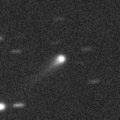
|
It brightened rapidly up to 13.5 mag (July 31, Chris Wyatt). It will be observable at 12-13 mag until autumn.
Date(TT) R.A. (2000) Decl. Delta r Elong. m1 Best Time(A, h)
Aug. 13 14 18.34 -13 44.6 2.026 2.042 76 12.8 18:52 (120, 55)
Aug. 20 14 31.38 -14 7.1 2.083 2.029 72 12.6 18:57 (114, 52)
|

|
It brightened up to 8-9 mag from winter to spring. Now it is fading. It has already faded down to 12.9 mag (July 23, Chris Wyatt). It will be unobservable soon. But it will appear in the morning sky at 14 mag in autumn.
Date(TT) R.A. (2000) Decl. Delta r Elong. m1 Best Time(A, h)
Aug. 13 11 50.04 12 22.6 4.262 3.466 33 12.6 18:52 (113, 11)
Aug. 20 11 55.66 10 45.2 4.374 3.523 28 12.8 18:57 (108, 7)
|

|
It passes the perihelion on Aug. 19. It is not observable now. In the Northern Hemisphere, it will be observable at 15 mag in good condition from September to October. In the Southern Hemisphere, it is not observable until November.
Date(TT) R.A. (2000) Decl. Delta r Elong. m1 Best Time(A, h)
Aug. 13 9 15.88 12 12.0 1.299 0.300 4 13.1 5:17 (264,-13)
Aug. 20 10 24.32 8 13.7 1.029 0.140 7 12.9 18:57 ( 93,-10)
|

|
Outburst occured on July 28. Now it is bright as 12.0 mag (Aug. 11, Juan Jose Gonzalez). It is observable in excellent condition in the Southern Hemisphere.
Date(TT) R.A. (2000) Decl. Delta r Elong. m1 Best Time(A, h)
Aug. 13 19 21.39 -25 45.1 5.032 5.913 147 13.3 21:52 (180, 81)
Aug. 20 19 18.99 -25 41.5 5.096 5.911 140 13.3 21:22 (180, 81)
|

|
Now it is 12.4 mag (Aug. 11, Juan Jose Gonzalez). It will be fading gradually after August. In the Northern Hemisphere, it keeps observable until early November. It becomes observable in the evening sky from July to September also in the Southern Hemisphere.
Date(TT) R.A. (2000) Decl. Delta r Elong. m1 Best Time(A, h)
Aug. 13 15 11.45 33 19.3 3.170 3.119 77 13.4 18:52 (165, 20)
Aug. 20 15 14.20 30 6.7 3.272 3.156 74 13.6 18:57 (157, 21)
|

|
It will brighten up to 13 mag in summer. But it keeps unobservable for a long time. It will appear in the morning sky in December, when the comet will be fainter than 15 mag.
Date(TT) R.A. (2000) Decl. Delta r Elong. m1 Best Time(A, h)
Aug. 13 9 7.53 9 31.4 2.426 1.429 7 13.5 5:17 (266,-10)
Aug. 20 9 31.41 7 40.2 2.412 1.417 8 13.4 5:09 (268,-10)
|
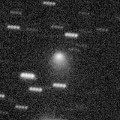
|
Now it is so bright as 12.7 mag (Aug. 4, Thomas Lehmann). It is observable in excellent condition in the Northern Hemispehre. In the Southern Hemisphere, it keeps locating low until August, but it will be observable in good condition after September.
Date(TT) R.A. (2000) Decl. Delta r Elong. m1 Best Time(A, h)
Aug. 13 23 27.90 45 27.3 1.235 1.893 114 13.9 2:04 (180, 9)
Aug. 20 22 34.81 42 45.9 1.122 1.886 124 13.7 0:44 (180, 12)
|
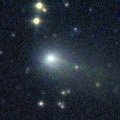
|
Now it is very bright as 12.5 mag (Aug. 3, Marco Goiato). It keeps observable in good condition for a while.
Date(TT) R.A. (2000) Decl. Delta r Elong. m1 Best Time(A, h)
Aug. 13 20 59.42 -14 32.5 1.565 2.573 172 13.8 23:30 (180, 70)
Aug. 20 20 56.26 -15 11.0 1.602 2.592 164 13.9 22:59 (180, 70)
|
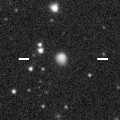
|
Now it is 14.2 mag (July 23, Artyom Novichonok). It is expected to brighten up to 7 mag in 2017 summer. In the Northern Hemisphere, it becomes low temporarily in summer, but it keeps observable in good condition until the highlight while the comet will be brightening. In the Southern Hemisphere, it is not observable until early 2017.
Date(TT) R.A. (2000) Decl. Delta r Elong. m1 Best Time(A, h)
Aug. 13 9 38.36 52 0.1 4.732 3.975 37 14.1 18:52 (134,-33)
Aug. 20 9 51.58 51 29.7 4.642 3.909 39 14.0 5:09 (227,-34)
|
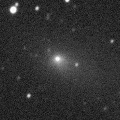
|
Now it is 13.6 mag (July 31, Chris Wyatt). Distant object, but it keeps observable at 14 mag for a long time from 2015 to 2016.
Date(TT) R.A. (2000) Decl. Delta r Elong. m1 Best Time(A, h)
Aug. 13 0 52.17 1 22.6 4.229 4.916 127 14.0 3:26 (180, 54)
Aug. 20 0 52.24 0 57.1 4.158 4.922 134 14.0 2:59 (180, 54)
|
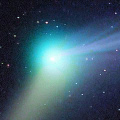
|
It brightened up to 6 mag from autumn to winter. Now it is fading. It has already faded down to 13.9 mag (July 14, Katsumi Yoshimoto). In the Northern Hemisphere, it will be getting higher in the morning sky. It is not observable after this in the Southern Hemisphere.
Date(TT) R.A. (2000) Decl. Delta r Elong. m1 Best Time(A, h)
Aug. 13 6 3.49 49 36.3 4.451 3.952 54 14.2 5:17 (210, -6)
Aug. 20 6 4.88 50 11.4 4.432 4.028 60 14.3 5:09 (207, -4)
|

|
It is not observable now. It will be observable at 16.5 mag in September in the Northern Hemisphere, or in November in the Southern Hemisphere.
Date(TT) R.A. (2000) Decl. Delta r Elong. m1 Best Time(A, h)
Aug. 13 8 28.11 15 46.4 2.991 2.031 15 14.8 5:17 (255, -6)
Aug. 20 8 44.45 14 58.2 2.983 2.044 17 15.0 5:09 (255, -5)
|
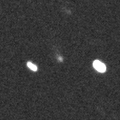
|
Now it is bright as 14.9 mag (May 4, Hidetaka Sato). It keeps 15 mag until autumn. In the Southern Hemisphere, it keeps observable for a long time. It will be unobservable after this in the Northern Hemisphere.
Date(TT) R.A. (2000) Decl. Delta r Elong. m1 Best Time(A, h)
Aug. 13 9 48.09 -57 11.9 2.487 2.377 71 15.1 18:52 ( 36, 25)
Aug. 20 10 24.98 -57 56.5 2.536 2.398 70 15.2 18:57 ( 36, 26)
|
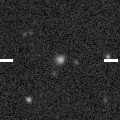
|
Now it is 16.4 mag (Aug. 12, Thomas Lehmann). It will be unobservable temporarily from summer to autumn. Then it will appear in the morning sky at 13 mag in December. It is expected to brighten up to 7 mag in 2017 spring. But it locates somewhat low at the high light.
Date(TT) R.A. (2000) Decl. Delta r Elong. m1 Best Time(A, h)
Aug. 13 11 43.68 -2 34.9 4.577 3.817 37 15.6 18:52 (100, 18)
Aug. 20 11 49.98 -3 8.9 4.562 3.742 31 15.5 18:57 ( 96, 14)
|

|
Now it is 14.2 mag (July 2, Chris Wyatt). In the Northern Hemisphere, it will be unobservable soon. In the Southern Hemisphere, it keeps observable in good condition until autumn. But it will be fading slowly after this.
Date(TT) R.A. (2000) Decl. Delta r Elong. m1 Best Time(A, h)
Aug. 13 13 37.29 -27 47.3 2.507 2.415 73 15.6 18:52 ( 90, 55)
Aug. 20 13 48.43 -28 53.6 2.591 2.427 69 15.7 18:57 ( 86, 51)
|
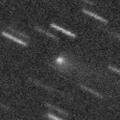
|
Now it is 15.4 mag (July 3, Hidetaka Sato), brighter than originally predicted. Now it is brightest. In the Southern Hemisphere, it keeps observable until winter, but it locates somewhat low. In the Northern Hemisphere, it will be getting higher after this, and it will be observable in excellent condition.
Date(TT) R.A. (2000) Decl. Delta r Elong. m1 Best Time(A, h)
Aug. 13 5 12.43 18 52.2 1.704 1.516 61 15.7 5:17 (219, 26)
Aug. 20 5 29.84 20 37.9 1.685 1.544 64 15.8 5:09 (218, 24)
|
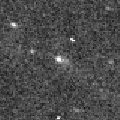
|
First return of a new periodic comet which brightened up to 16.5 mag in 2008. The condition of this apparition is very good. It is expected to brighten up to 15.5 mag in autumn and will be observable in good condition. Now it is 18.8 mag (July 3, E. Schwab, D. Abreu), fainter than predicted by 2 mag.
Date(TT) R.A. (2000) Decl. Delta r Elong. m1 Best Time(A, h)
Aug. 13 0 28.26 -16 48.8 1.568 2.414 137 15.8 3:02 (180, 72)
Aug. 20 0 24.89 -16 24.8 1.505 2.400 144 15.7 2:31 (180, 71)
|
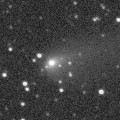
|
Now it is 13.9 mag (July 2, Chris Wyatt). It will be fading gradually after this. It is observable in excellent condition in the Southern Hemisphere. But it locates somewhat low in the Northern Hemisphere.
Date(TT) R.A. (2000) Decl. Delta r Elong. m1 Best Time(A, h)
Aug. 13 15 43.96 -23 29.4 2.274 2.624 98 15.8 18:52 (143, 76)
Aug. 20 15 51.46 -23 47.5 2.384 2.648 93 16.0 18:57 (126, 73)
|
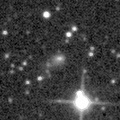
|
Now it is 15.7 mag (June 28, H. Mikuz). It will be observable at 13 mag for a long time from 2017 to 2018. In 2016, it keeps observable at 16-17 mag in good condition until autumn.
Date(TT) R.A. (2000) Decl. Delta r Elong. m1 Best Time(A, h)
Aug. 13 19 2.76 -9 53.3 5.151 5.995 143 16.1 21:33 (180, 65)
Aug. 20 18 56.77 -9 44.6 5.187 5.953 135 16.1 21:00 (180, 65)
|
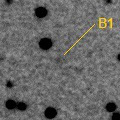
|
Now it is 16.2 mag (June 29, iTelescope Observatory, Siding Spring). It keeps 16 mag for a long time from 2016 to 2017. In 2016, it is observable in excellent condition in the Southern Hemisphere, but it locates extremely low in the Northern Hemispehre.
Date(TT) R.A. (2000) Decl. Delta r Elong. m1 Best Time(A, h)
Aug. 13 13 9.90 -21 4.6 3.696 3.384 64 16.4 18:52 ( 95, 46)
Aug. 20 13 19.01 -20 31.1 3.763 3.364 59 16.4 18:57 ( 92, 41)
|
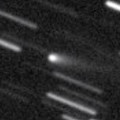
|
Now it is 16.1 mag (Aug. 10, Denis Buczynski). It will be observable at 16 mag in good condition from autumn to winter. It locates somewhat low in the Southern Hemisphere.
Date(TT) R.A. (2000) Decl. Delta r Elong. m1 Best Time(A, h)
Aug. 13 3 50.16 26 42.3 2.498 2.516 79 16.5 5:17 (197, 26)
Aug. 20 3 59.98 27 34.9 2.422 2.521 83 16.4 5:09 (194, 26)
|
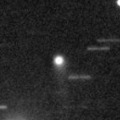
|
Now it is 16.2 mag (July 16, G. Borisov, A. Novichonok). It will brighten up to 14 mag from summer to winter in 2017. Then it will be observable in excellent condition in the Northern Hemisphere. In the Southern Hemisphere, it is hardly observable around the highlight.
Date(TT) R.A. (2000) Decl. Delta r Elong. m1 Best Time(A, h)
Aug. 13 0 17.00 -18 3.9 4.041 4.863 140 16.6 2:51 (180, 73)
Aug. 20 0 11.70 -18 2.0 3.938 4.820 147 16.5 2:18 (180, 73)
|
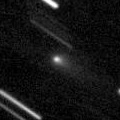
|
Now it is very bright as 14.7 mag (July 31, Thomas Lehmann). It had been lost for a long time over 200 years since its discovery in 1783. The condition of this apparition is excellent, and it will brighten up to 15 mag in autumn. In the Northern Hemisphere, it will be getting higher rapidly after this, and will be observable in excellent condition from summer to winter. In the Southern Hemisphere, it keeps observable in good condition until November.
Date(TT) R.A. (2000) Decl. Delta r Elong. m1 Best Time(A, h)
Aug. 13 4 32.51 0 29.1 1.758 1.790 75 16.7 5:17 (222, 46)
Aug. 20 4 42.94 2 28.5 1.686 1.783 78 16.6 5:09 (217, 46)
|

|
Now it is 16.1 mag (July 7, Kunihiro Shima). It keeps 16.5 mag from 2016 to 2017. It is observable in good condition in the Northern Hemisphere. In the Southern Hemisphere, it locates low in 2016, and it is not observable in 2017.
Date(TT) R.A. (2000) Decl. Delta r Elong. m1 Best Time(A, h)
Aug. 13 16 32.00 35 8.9 6.155 6.298 93 16.7 19:03 (180, 20)
Aug. 20 16 31.48 34 53.0 6.216 6.292 89 16.7 18:57 (175, 20)
|
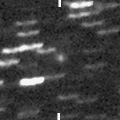
|
Now it is 16.5 mag (July 2, P. Carson). It will brighten up to 16.5 mag in summer and will be observable in good condition.
Date(TT) R.A. (2000) Decl. Delta r Elong. m1 Best Time(A, h)
Aug. 13 17 34.11 -11 6.4 1.986 2.667 122 16.7 20:05 (180, 66)
Aug. 20 17 35.34 -11 16.5 2.043 2.648 116 16.7 19:39 (180, 66)
|
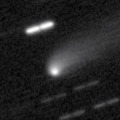
|
It brightened very rapidly in 2015 spring, and reached up to 13.8 mag (2015 May 11, Sandor Szabo). Now it is 15.7 mag (June 7, Yasukazu Ikari). In the Northern Hemisphere, it will be unobservable in August. In the Southern Hemisphere, it keeps observable until October, but it will be fading.
Date(TT) R.A. (2000) Decl. Delta r Elong. m1 Best Time(A, h)
Aug. 13 14 6.45 -24 49.0 4.677 4.571 77 16.8 18:52 (100, 59)
Aug. 20 14 11.91 -24 56.8 4.806 4.602 72 16.9 18:57 ( 95, 54)
|
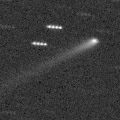
|
It brightened up to 15 mag from late 2014 to early 2016. Now it is fading slowly. Now it is 16.6 mag (June 16, Catalina Sky Survey). In the Northern Hemisphere, it will be observable at 17 mag in autumn in good condition. It locates extremely low in the Southern Hemisphere.
Date(TT) R.A. (2000) Decl. Delta r Elong. m1 Best Time(A, h)
Aug. 13 23 22.21 43 55.4 4.518 5.048 116 16.9 1:57 (180, 11)
Aug. 20 23 10.45 44 18.2 4.486 5.080 120 16.9 1:17 (180, 11)
|
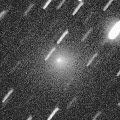
|
It brightened up to 10-11 mag in May. Now it is fading rapidly. It is already fainter than 17.0 mag (Aug. 6, Thomas Lehmann). It keeps observable in good condition until September.
Date(TT) R.A. (2000) Decl. Delta r Elong. m1 Best Time(A, h)
Aug. 13 15 0.10 12 3.7 2.096 2.156 79 16.9 18:52 (154, 39)
Aug. 20 14 57.59 9 0.2 2.289 2.225 73 17.5 18:57 (142, 38)
|
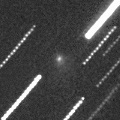
|
Now it is 17.5 mag (June 17, Catalina Sky Survey). It keeps 17-18 mag until autumn. It keeps observable in excellent condition in the Northern Hemisphere. It will be getting lower gradually in the Southern Hemisphere.
Date(TT) R.A. (2000) Decl. Delta r Elong. m1 Best Time(A, h)
Aug. 13 20 52.01 34 57.6 1.537 2.318 129 17.1 23:20 (180, 20)
Aug. 20 20 24.60 36 37.3 1.585 2.331 126 17.2 22:25 (180, 18)
|
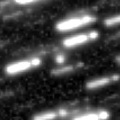
|
Now it is 18.4 mag (June 30, C. Jacques, E. Pimentel, J. Barros). It will brighten up to 16 mag and will be observable in good condition in 2017. In 2016, it is observable in excellent condition in the Southern Hemisphere, but it keeps low in the Northern Hemisphere.
Date(TT) R.A. (2000) Decl. Delta r Elong. m1 Best Time(A, h)
Aug. 13 18 39.73 -39 7.0 2.473 3.271 135 17.2 21:11 ( 0, 86)
Aug. 20 18 37.62 -38 35.0 2.523 3.253 128 17.1 20:41 ( 0, 86)
|
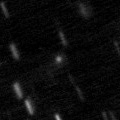
|
Now it is 17.8 mag (June 30, A. Maury, J.-B. de Vanssay, J.-F. Soulier, J.-G. Bosch, T. Noel). It keeps 17 mag for a long time in 2016, and it will be observable in excellent condition in the Southern Hemisphere. It is hardly observable in the Northern Hemisphere.
Date(TT) R.A. (2000) Decl. Delta r Elong. m1 Best Time(A, h)
Aug. 13 3 21.96 -44 48.9 3.140 3.493 101 17.3 5:17 (326, 78)
Aug. 20 3 12.15 -46 20.9 3.082 3.511 106 17.3 5:09 (352, 79)
|

|
It brightened up to 13-14 mag from 2014 to 2015. Now it is fading. It has already faded down to 16.6 mag (June 5, Space Surveillance Telescope, Atom Site). It will be observable at 17 mag in 2016.
Date(TT) R.A. (2000) Decl. Delta r Elong. m1 Best Time(A, h)
Aug. 13 23 21.35 -4 6.8 4.647 5.555 150 17.3 1:56 (180, 59)
Aug. 20 23 19.02 -4 30.6 4.646 5.599 158 17.4 1:26 (180, 59)
|

|
It has been lost since its discovery in 1978. In 2016, it is expected to return in excellent condition from autumn to winter.
Date(TT) R.A. (2000) Decl. Delta r Elong. m1 Best Time(A, h)
Aug. 13 19 38.97 -31 59.2 0.702 1.655 149 17.7 22:09 (180, 87)
Aug. 20 19 33.69 -32 25.3 0.688 1.609 141 17.4 21:37 (180, 87)
|
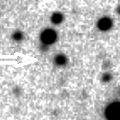
|
Now it is 17.4 mag (Aug. 5, Jean-Gabriel Bosch). It will brighten up to 13 mag and will be observable in good condition in 2017 summer. In 2016, it keeps observable until winter when it will brighten up to 15.5 mag. It locates somewhat low in the Southern Hemisphere.
Date(TT) R.A. (2000) Decl. Delta r Elong. m1 Best Time(A, h)
Aug. 13 3 39.27 30 25.1 4.678 4.628 80 17.5 5:17 (193, 23)
Aug. 20 3 36.72 30 43.9 4.499 4.577 88 17.4 5:09 (188, 24)
|
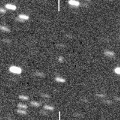
|
First return of a new periodic comet discovered in 2008. Now it is 18.0 mag (July 9, Kunihiro Shima). It keeps observable at 17.5 mag until autumn.
Date(TT) R.A. (2000) Decl. Delta r Elong. m1 Best Time(A, h)
Aug. 13 20 13.22 -19 4.8 2.130 3.104 160 17.5 22:44 (180, 74)
Aug. 20 20 9.49 -19 13.0 2.162 3.099 153 17.5 22:12 (180, 74)
|
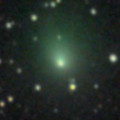
|
It brightened up to 10 mag in 2015 autumn. Now it is appearing in the morning sky. However, it has already faded down to 16.8 mag (June 13, iTelescope Observatory, Siding Spring).
Date(TT) R.A. (2000) Decl. Delta r Elong. m1 Best Time(A, h)
Aug. 13 3 31.16 13 58.6 2.857 2.974 86 17.5 5:17 (195, 40)
Aug. 20 3 34.99 14 2.0 2.798 3.014 92 17.6 5:09 (190, 40)
|

|
It brightened up to 3.7 mag and became a naked eye comet in mid January in 2015 (Jan. 13, Marek Biely). Now it is fading. It has already faded down to 17.1 mag (July 3, Kunihiro Shima). In the Northern Hemisphere, it keeps observable for a long time until the comet fades out. It locates somewhat low in the Southern Hemisphere.
Date(TT) R.A. (2000) Decl. Delta r Elong. m1 Best Time(A, h)
Aug. 13 17 16.76 20 16.9 6.037 6.428 108 17.5 19:48 (180, 35)
Aug. 20 17 15.35 19 19.2 6.175 6.488 103 17.6 19:19 (180, 36)
|
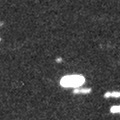
|
It will brighten up to 15 mag and will be observable in good condition from autum to winter in 2017. In the Northern Hemisphere, it keeps observable in good condition for a long time while the comet will be brightening. It is not observable until 2017 summer in the Southern Hemisphere.
Date(TT) R.A. (2000) Decl. Delta r Elong. m1 Best Time(A, h)
Aug. 13 5 19.21 56 8.8 6.220 5.829 62 17.6 5:17 (201, -7)
Aug. 20 5 19.34 56 30.6 6.088 5.793 68 17.6 5:09 (198, -6)
|
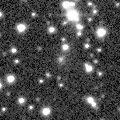
|
It will pass the perihelion in 2019. However, it has not been brightening since the discovery in 2010. Now it is 17.7 mag (Apr. 3, D. Buczynski). It keeps observable in excellent condition in the Northern Hemisphere. It is not observable in the Southern Hemisphere.
Date(TT) R.A. (2000) Decl. Delta r Elong. m1 Best Time(A, h)
Aug. 13 4 36.19 54 11.8 10.351 10.027 68 17.6 5:17 (196, -3)
Aug. 20 4 38.67 54 46.8 10.238 10.006 73 17.6 5:09 (194, -2)
|
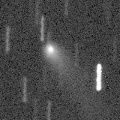
|
It was observed at 14-15 mag from 2014 to 2015. Now it is fading. In the Northern Hemisphere, it keeps observable in excellent condition until winter when the comet will be fainter than 18 mag. It is not observable in the Southern Hemisphere.
Date(TT) R.A. (2000) Decl. Delta r Elong. m1 Best Time(A, h)
Aug. 13 4 23.33 72 4.5 6.053 5.822 72 17.6 5:17 (188,-19)
Aug. 20 4 31.57 73 19.0 6.031 5.863 75 17.6 5:09 (187,-19)
|
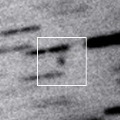
|
Now it is 17.4 mag (July 2, G. Gunn, G. W. Christie). It keeps observable at 17.5 mag in good condition from spring to autumn in the Southern Hemisphere. It is not observable in the Northern Hemisphere.
Date(TT) R.A. (2000) Decl. Delta r Elong. m1 Best Time(A, h)
Aug. 13 17 33.95 -60 37.0 4.423 4.973 117 17.7 20:06 ( 0, 64)
Aug. 20 17 35.60 -59 48.4 4.488 4.971 112 17.7 19:40 ( 0, 65)
|

|
It was observed as bright as 13-14 mag for a long time from 2011 to 2014. Now it is fading. It is observable in excellent condition in the Southern Hemisphere. It locates extremely low in the Northern Hemisphere. No observations have been reported since August, 2015.
Date(TT) R.A. (2000) Decl. Delta r Elong. m1 Best Time(A, h)
Aug. 13 17 0.61 -37 33.7 9.375 9.868 116 17.8 19:32 ( 0, 87)
Aug. 20 16 58.49 -37 32.8 9.518 9.903 109 17.8 19:02 ( 0, 87)
|

|
It has brightened in outburst up to 14 mag twice, in 2006 January and 2011 May. It is observable at 17 mag in good condition in autumn.
Date(TT) R.A. (2000) Decl. Delta r Elong. m1 Best Time(A, h)
Aug. 13 1 28.22 7 22.3 5.716 6.246 117 17.8 4:02 (180, 48)
Aug. 20 1 28.02 7 16.6 5.634 6.257 124 17.8 3:34 (180, 48)
|
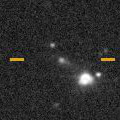
|
It was expected to brighten up to 16 mag and observable in good condition in autumn. But actually, it is fainter than originally predicted by 2 mag. It is 18.6 mag now (June 30, A. Maury, J.-B. de Vanssay, J.-F. Soulier, J.-G. Bosch, T. Noel).
Date(TT) R.A. (2000) Decl. Delta r Elong. m1 Best Time(A, h)
Aug. 13 23 13.35 -11 39.7 1.912 2.862 155 18.0 1:48 (180, 67)
Aug. 20 23 9.36 -11 45.3 1.861 2.843 162 17.9 1:16 (180, 67)
|

|
Now it is 17.1 mag (July 9, Kunihiro Shima). It was expected to brighten up to 14 mag from winter to summer. But it is much fainter actually. It will be observable in excellent condition in the Southern Hemisphere. It locates low in the Northern Hemisphere.
Date(TT) R.A. (2000) Decl. Delta r Elong. m1 Best Time(A, h)
Aug. 13 16 21.86 -38 8.6 2.746 3.219 108 19.2 18:54 ( 0, 87)
Aug. 20 16 27.95 -37 57.0 2.883 3.271 103 19.3 18:57 ( 57, 84)
|
|
![]()
 29P/Schwassmann-Wachmann 1
29P/Schwassmann-Wachmann 1 C/2014 W2 ( PanSTARRS )
C/2014 W2 ( PanSTARRS ) C/2015 TQ209 ( LINEAR )
C/2015 TQ209 ( LINEAR ) C/2016 A8 ( LINEAR )
C/2016 A8 ( LINEAR ) 53P/Van Biesbroeck
53P/Van Biesbroeck C/2015 V2 ( Johnson )
C/2015 V2 ( Johnson ) C/2011 KP36 ( Spacewatch )
C/2011 KP36 ( Spacewatch ) C/2013 US10 ( Catalina )
C/2013 US10 ( Catalina ) 118P/Shoemaker-Levy 4
118P/Shoemaker-Levy 4 C/2015 T4 ( PanSTARRS )
C/2015 T4 ( PanSTARRS ) C/2015 ER61 ( PanSTARRS )
C/2015 ER61 ( PanSTARRS ) 77P/Longmore
77P/Longmore 146P/Shoemaker-LINEAR
146P/Shoemaker-LINEAR 339P/2016 N1 ( McNaught )
339P/2016 N1 ( McNaught ) 116P/Wild 4
116P/Wild 4 C/2015 O1 ( PanSTARRS )
C/2015 O1 ( PanSTARRS ) C/2016 B1 ( NEOWISE )
C/2016 B1 ( NEOWISE ) 56P/Slaughter-Burnham
56P/Slaughter-Burnham C/2016 N4 ( MASTER )
C/2016 N4 ( MASTER ) 226P/Pigott-LINEAR-Kowalski
226P/Pigott-LINEAR-Kowalski C/2014 OE4 ( PanSTARRS )
C/2014 OE4 ( PanSTARRS ) 219P/LINEAR
219P/LINEAR C/2014 W11 ( PanSTARRS )
C/2014 W11 ( PanSTARRS ) C/2014 A4 ( SONEAR )
C/2014 A4 ( SONEAR ) C/2015 WZ ( PanSTARRS )
C/2015 WZ ( PanSTARRS ) C/2016 K1 ( LINEAR )
C/2016 K1 ( LINEAR ) 47P/Ashbrook-Jackson
47P/Ashbrook-Jackson C/2015 B2 ( PanSTARRS )
C/2015 B2 ( PanSTARRS ) C/2012 F3 ( PanSTARRS )
C/2012 F3 ( PanSTARRS ) D/1978 R1 ( Haneda-Campos )
D/1978 R1 ( Haneda-Campos ) C/2015 VL62 ( Lemmon-Yeung-PanSTARRS )
C/2015 VL62 ( Lemmon-Yeung-PanSTARRS ) 340P/2016 N2 ( Boattini )
340P/2016 N2 ( Boattini ) 22P/Kopff
22P/Kopff C/2014 Q2 ( Lovejoy )
C/2014 Q2 ( Lovejoy ) C/2015 V1 ( PanSTARRS )
C/2015 V1 ( PanSTARRS ) C/2010 U3 ( Boattini )
C/2010 U3 ( Boattini ) C/2014 N3 ( NEOWISE )
C/2014 N3 ( NEOWISE ) C/2015 H2 ( PanSTARRS )
C/2015 H2 ( PanSTARRS ) C/2010 S1 ( LINEAR )
C/2010 S1 ( LINEAR ) 174P/(60558) 2000 EC98 ( Echeclus )
174P/(60558) 2000 EC98 ( Echeclus ) 188P/LINEAR-Mueller
188P/LINEAR-Mueller C/2014 Y1 ( PanSTARRS )
C/2014 Y1 ( PanSTARRS )![]()















































